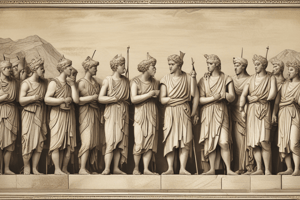Podcast
Questions and Answers
What were the primary reforms introduced by Drakon, and what conflict did they create?
What were the primary reforms introduced by Drakon, and what conflict did they create?
Drakon introduced laws to address debt slavery among farmers, but these reforms failed to fully resolve the issue, leading to further conflict.
How did Solon's reforms impact the social structure of Athens?
How did Solon's reforms impact the social structure of Athens?
Solon's reforms abolished debt slavery and redistributed land, yet the existing social inequalities and class structures largely remained intact.
Describe Peisistratos' approach to governance and its effects on Athenian society.
Describe Peisistratos' approach to governance and its effects on Athenian society.
Peisistratos established himself as a tyrant through political and military means, prioritizing farming and commerce while supporting the common people.
What was the significance of Kleisthenes' reforms in the development of Athenian democracy?
What was the significance of Kleisthenes' reforms in the development of Athenian democracy?
In what ways did Perikles contribute to the flourishing of Athenian democracy during the 5th century BCE?
In what ways did Perikles contribute to the flourishing of Athenian democracy during the 5th century BCE?
Flashcards
Drakon's Laws
Drakon's Laws
7th Century BCE laws regarding debt slavery, affecting farmers, but not fully resolving the issue.
Solon's Reforms
Solon's Reforms
6th Century BCE reforms abolishing debt slavery and redistributing land, partially addressing social inequality; aiming for balance in wealth classes.
Peisistratos's Reign
Peisistratos's Reign
6th Century BCE tyrant who used political power and military support to control the city (acropolis) and structured society for farming/commerce to favor the common people. Struggles and overthrown later.
Kleisthenes' Reforms
Kleisthenes' Reforms
Signup and view all the flashcards
Athenian Democracy's Golden Age (5th Century BCE)
Athenian Democracy's Golden Age (5th Century BCE)
Signup and view all the flashcards
Study Notes
The Development of Democracy
- Drakon (7th Century BCE): Debt slavery of farmers by nobles. This led to conflict and reform attempts by Drakon. Drakon's reforms included a ban on blood feuds but did not fully resolve the issue of debt slavery. Legal codes were established, but their effectiveness was limited
- Solon (6th Century BCE): Abolition of debt slavery. His reforms included returning land to farmers and creating a four-tiered class system based on wealth. To ensure representation, he created councils where representatives from each class could voice their concerns and make decisions.
- Peisistratos (6th Century BCE): A noble who seized power and established a tyranny. Peasants were supported by redistributing land seized from exiled aristocrats. Economic growth was encouraged through trade and business. He was overthrown and followed by his sons who were also overthrown.
- Kleisthenes (6th Century BCE): Divided the four traditional tribes into ten new tribes. This allowed for broader participation in governance and prevented the rise of a single powerful family. Used the ostracism system; citizens could vote to exile someone with too much power.
- Pericles (5th Century BCE): Strengthened democracy. The Assembly became more important. Paid officials could participate in civic affairs. Courts were composed of citizens who served as judges. Large-scale public works projects were implemented, stimulating the economy and community spirit. Expanded public participation by inviting and engaging diverse populations.
Studying That Suits You
Use AI to generate personalized quizzes and flashcards to suit your learning preferences.



